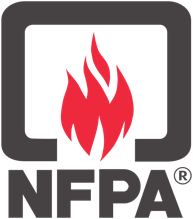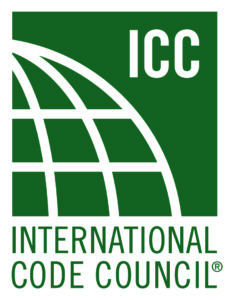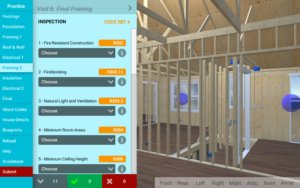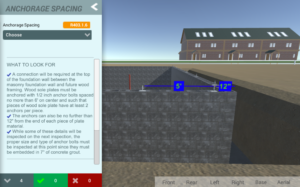As demand for skilled labor surges in the construction industry, online simulations offer interactive training for students and tradesmen
There is a shortage of skilled labor in the construction industry that is leading to higher building costs and slower construction. The National Association of Homebuilders estimates that there are approximately 200,000 unfilled construction jobs in the U.S.—a jump of 81% in the last two years[i]. According to the Associated General Contractors of America, nearly 80% of construction businesses report they are having a hard time finding qualified skilled labor[ii].
Restocking the Building Code Knowledge Base

Building code knowledge is another area that’s in high demand as Code compliance is required in each phase of construction. New professionals: apprentices, contractors, inspectors, engineers and architects will need to ramp up their Code knowledge. Jurisdictions require these individuals to administer building codes effectively for safe residential structures. Further, the inspectors that ensure Code compliance are retiring at a steep rate. More than 80% of the existing code workforce is planning to retire in the next 15 years, with more than 30% in the next five years.
Some states are responding by increasing funding for training in the skilled construction trades to entice more workers into the field.
 Cengage has partnered with leading education and training providers, such as the International Code Council (ICC) and the National Fire Protection Association (NFPA) to provide education materials for students and tradesmen. All three organizations: Cengage, ICC and NFPA, have collaborated together to develop an immersive, 3D training simulation: the Training Simulations for Residential Construction Codes. This product serves any student or professional needing to understand and apply the National Electric Code (NEC) and International Residential Code (IRC). Students are able to benefit from the expertise of NFPA and ICC which is highly regarded in the building and electrical fields. Both are leading code, education and training organizations providing in-person and online instruction and producing dozens of educational materials.
Cengage has partnered with leading education and training providers, such as the International Code Council (ICC) and the National Fire Protection Association (NFPA) to provide education materials for students and tradesmen. All three organizations: Cengage, ICC and NFPA, have collaborated together to develop an immersive, 3D training simulation: the Training Simulations for Residential Construction Codes. This product serves any student or professional needing to understand and apply the National Electric Code (NEC) and International Residential Code (IRC). Students are able to benefit from the expertise of NFPA and ICC which is highly regarded in the building and electrical fields. Both are leading code, education and training organizations providing in-person and online instruction and producing dozens of educational materials.
Training for the Future
As the skilled trades have evolved over the years, so has training. Today’s era of training involves game-based online simulations to guide students and professionals in understanding everything from complicated building codes to electrical wiring sequences and beyond. Learning can now be done at the users’ convenience and provide more immediate assessment to a learner, employer, or certifying body.
Simulations go beyond the book to teach Code in an experiential, visual manner. This is especially important for learners that need to translate code provisions into hands-on application.

This is critical for new tradesmen or inspectors new to visually assessing homes, explains Vanessa Myers, former Sr. Product Manager at Cengage.
“When physical buildings are used for training, providing variability in the Code violations is time-consuming and expensive. With these simulations, we’re delivering the next generation of Code training. There’s nothing else like it on the market,” says Myers. “The trades are looking for new ways to entice workers and inspectors. Cutting-edge training solutions like this are one way to do that.”
“The residential code simulation training is the cutting edge digital training for professionals at all levels. It is the closest thing available to actual and hands-on field training experience.”
– Hamid Naderi, Senior VP for Product Development, P.E. ICC
The simulations built into MindTap offer a 3D, interactive, simulation program. Users access a hands-on, skill-building experience to understand and apply the electrical and residential code throughout the residential construction process. Users virtually navigate a residential construction site, stopping at code inspection points during every phase of the construction process, to determine code compliance. Along the way, code violations are identified as they would appear on a job site. Randomization of Code violations in a simulated environment allows for a fresh exploration each time a student enters the house. When used in a construction or electrical course, Code violations can be assignable to align directly with course curricula and competencies, and metrics can be provided back to instructors or employers.
“This collaboration allows us to take our vast amount of electrical code knowledge and deliver it in a way that adds increased value to those who rely on NFPA information to do their jobs and deliver it in a way that mirrors real life experience like never before.”
– Kim Fontes, Director of Product Development, NFPA
Designed for professionals and students in technical or apprenticeship programs, the Residential Construction Codes simulation is available at an affordable $50.

Simulations Bring Training to Life Across Industries
Cengage also offers a robust online training simulation program across many constructions trades and other skilled areas including simulations for residential wiring, HVAC and electricity for HVAC, welding, automotive theory (new), automotive diagnostics and robotics. To learn more, visit the Cengage Instructor Center.
[i] //www.reuters.com/article/us-usa-housing-labor-idUSKCN11C0F7
[ii] //www.tradesmeninternational.com/news/the-construction-labor-shortage-where-did-all-the-skilled-labor-go/

